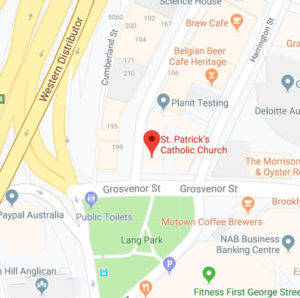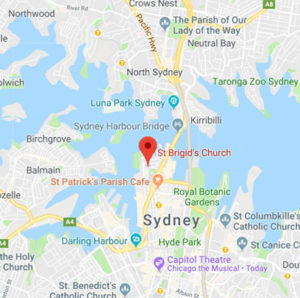After the completion of St Patrick’s church in Grosvenor St., The Rocks, in 1844, St Bridget’s became incorporated in the newly-established parish centred around St Patrick’s. In 1868, the parish of St Patrick’s was entrusted to the Marist Fathers under Father Joseph Monnier SM, who also became responsible for St Bridget’s. Father Monnier built another school, confusingly known as St Bridget’s Hall, at 107 Kent Street, at the intersection with High Street.
A separate parish of St Bridget’s was created in 1874. For most of the five years of its existence, the parish priest was Father Pierre Jonghe (anglicised as Peter Young). However, many of the parishioners wished to continue being part of St Patrick’s parish, and in any case the new parish was too small to be viable in its own right. It was returned to the care of the Marist Fathers in 1880.
Sometime in the years 1865-75 an extension for a sanctuary and sacristy area was added to the eastern end of the building; and at the same time or a little later, a choir gallery was constructed at the western end of the building. In 1880 a finely decorated bronze bell, cast by Bardin Aine of Lyons in France, was installed on the northern wall of St Brigid’s. It is still in use today.
For about 20 years the Marist Fathers linked St Bridget’s with a third parish church they built in 1882, St Michael’s, in Cumberland Street, The Rocks. The St Bridget’s – St Michael’s combine was run as a separate sub-parish during these years, with its own resident Marist clergy living at St Michael’s. Fr Peter Piquet was in charge there in 1882, shortly after his arrival in Sydney.
The Sisters of St Joseph took charge of St Bridget’s school in 1880, along with St Bridget’s Hall. They lived in Cheshunt House, beside St Michael’s. There they also established a Providence, or orphanage, on the corner of Lower Fort Street, Cumberland Street, and George Street North. The Harbour View Hotel occupies the site today. The confusion of having two schools, both called St Bridget’s and both in Kent Street, was finally ended in 1888 with the sale of the St Bridget’s Hall property.


